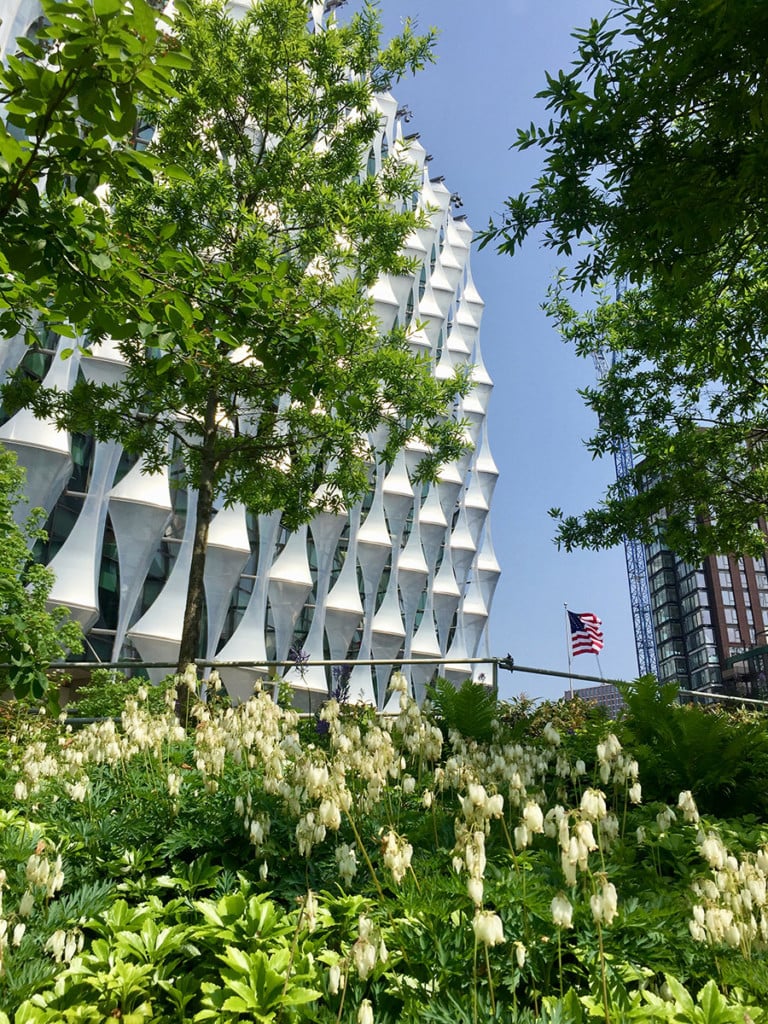
July 1, 2019
How the U.S. Embassy in London Uses Landscape as an Ambassador
The project, which includes design by KieranTimberlake and OLIN, features public spaces that plug into the surrounding neighborhood as well as plantings that evoke American landscapes.

The old American embassy in London was a cumbersome presence in Mayfair, an affluent, built-up area in the heart of the British capital. After its completion in 1960, the Eero Saarinen–designed building became notorious for its increasingly obtrusive security measures. “This unfriendly exterior didn’t really send the message that we wanted in a diplomatic facility,” says Hallie Boyce, partner at landscape architecture practice OLIN, which recently completed the landscape around the new embassy across the Thames. “The key goal of the project was, for the first time ever, to give a portion of an American embassy site over to the public,” Boyce says.
Designed by Philadelphia firm KieranTimberlake, the embassy building is a glittering cuboid of glass and translucent plastic fins. Raised on a plinth, it is an organizing element of Nine Elms, a rapidly developing former light-industrial area—and a sharp contrast to the embassy’s previous, rarefied context. (The move incensed President Trump, who called Nine Elms a “horrible location.”) Striving to set up the campus to be a good neighbor, OLIN conceived publicly accessible gardens to the north of the embassy and an urban plaza to its south, integrated within a greenway proposed to run through the area. (OLIN was involved in the project from the master-planning stage.) The intention is to capture the circulation of people walking along the river’s edge, luring them in to enjoy the shade of trees and the calming sound of a waterfall. “It’s working to give a portion of the site over to the public realm, trying to connect with pedestrians and give them a sense of welcome and openness,” Boyce says, describing these qualities as “American values.”
OLIN’s design had to meet the precepts outlined in the 2011 Embassy Perimeter Improvement Concepts & Design Guidelines, which set out the goal of “improving the quality and appeal of the built environment surrounding United States diplomatic facilities abroad.” Those guidelines from the U.S. Department of State Bureau of Overseas Buildings Operations are meant to shake off a hostile, fortresslike official presence around the world.

At the same time, the politically sensitive nature of the site demanded certain security features, which the firm provided through multipurpose design elements, Boyce explains. A low wall, for example, provides seating and doubles as an anti-ram device, while a hedge—typical of English parks—conceals bollards.
England’s landscaping tradition is also reflected in elements such as the moatlike pond that surrounds the building, which Boyce insists is not for security, but rather a means of capturing, purifying, and storing stormwater. OLIN worked with American and English horticulturists in selecting plant species, constantly referring back to the well-known transatlantic correspondence between 18th-century botanists John Bartram and Peter Collinson. (The two exchanged numerous letters about North American and European plants, as well as their seeds and cuttings.) “The planting design is really focused on capturing the exchange of those ideas,” says Boyce. Many species, for example, were chosen because they were brought to the New World by British settlers.
But the design also draws upon landscapes that are quintessentially American—including wetlands, prairies, and woodlands—using species endemic to the United States, such as bald cypress, river birch, and red maple. A spiraling meadow landscape and six interior gardens—three of which open to the outside—evoke landscapes from the lush Pacific Northwest and the canyons of the Southwest. The private gardens inside “also provide alternative circulation in the building, as well as places for social interaction and exchange,” Boyce says, adding that it’s rare for embassies to design for breakout space for the staff of different departments to interact.
As the gardens bed into their local context, and the surrounding area under- goes a transformation of its own, Nine Elms’ community of residents and workers is primed to enjoy this new landscape more and more.
You may also enjoy “Sidewalk Labs Releases Master Plan for Its Toronto Smart City Development.”
Would you like to comment on this article? Send your thoughts to: [email protected]







